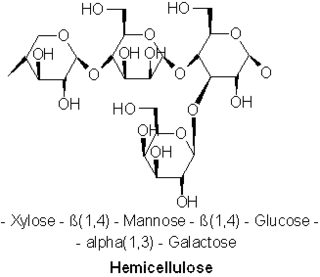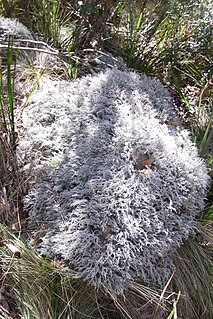
A cell wall is a structural layer surrounding some types of cells, just outside the cell membrane. It can be tough, flexible, and sometimes rigid. It provides the cell with both structural support and protection, and also acts as a filtering mechanism. Cell walls are absent in animals but are present in most other eukaryotes including algae, fungi and plants and in most prokaryotes. A major function is to act as pressure vessels, preventing over-expansion of the cell when water enters.

A hemicellulose is one of a number of heteropolymers, such as arabinoxylans, present along with cellulose in almost all terrestrial plant cell walls. While cellulose is crystalline, strong, and resistant to hydrolysis, hemicelluloses have random, amorphous structure with little strength. They are easily hydrolyzed by dilute acid or base as well as a myriad of hemicellulase enzymes.

Cellulase is any of several enzymes produced chiefly by fungi, bacteria, and protozoans that catalyze cellulolysis, the decomposition of cellulose and of some related polysaccharides. The name is also used for any naturally occurring mixture or complex of various such enzymes, that act serially or synergistically to decompose cellulosic material.

The molecule laminarin (also known as laminaran) is a storage glucan (a polysaccharide of glucose) found in brown algae. It is used as a carbohydrate food reserve in the same way that chrysolaminarin is used by phytoplankton, especially in diatoms. It is created by photosynthesis and is made up of β(1→3)-glucan with β(1→6)-branches. It is a linear polysaccharide, with a β(1→3):β(1→6) ratio of 3:1. Its hydrolysis is catalyzed by enzymes such as laminarinase (EC 3.2.1.6) that breaks the β(1→3) bonds. It has been suggested that the annual production of algae laminarin amounts to 12 ± 8 gigatons, i.e., about three times the annual atmospheric CO2 increase by fossil fuel burning, that its concentration is driven by light variability and that it contributes substantially to the carbon export from surface waters, as it may account for up to half of organic carbon in sinking diatom-containing particles.
A glucan is a polysaccharide derived from D-glucose, linked by glycosidic bonds. Many beta-glucans are medically important. They represent a drug target for antifungal medications of the echinocandin class.

Beta-amylase is an enzyme with the systematic name 4-alpha-D-glucan maltohydrolase. This enzyme catalyses the following chemical reaction:

Beta-glucans, β-glucans comprise a group of β-D-glucose polysaccharides (glucans) naturally occurring in the cell walls of cereals, bacteria, and fungi, with significantly differing physicochemical properties dependent on source. Typically, β-glucans form a linear backbone with 1–3 β-glycosidic bonds but vary with respect to molecular mass, solubility, viscosity, branching structure, and gelation properties, causing diverse physiological effects in animals.

The UDP-forming form of cellulose synthase is the main enzyme that produces cellulose. Systematically, it is known as UDP-glucose:(1→4)-β-D-glucan 4-β-D-glucosyltransferase in enzymology. It catalyzes the chemical reaction:
Oligosaccharides and polysaccharides are an important class of polymeric carbohydrates found in virtually all living entities. Their structural features make their nomenclature challenging and their roles in living systems make their nomenclature important.

α-Glucans (alpha-glucans) are polysaccharides of D-glucose monomers linked with glycosidic bonds of the alpha form. α-Glucans use cofactors in a cofactor site in order to activate a glucan phosphorylase enzyme. This enzyme causes a reaction that transfers a glucosyl portion between orthophosphate and α-I,4-glucan. The position of the cofactors to the active sites on the enzyme are critical to the overall reaction rate thus, any alteration to the cofactor site leads to the disruption of the glucan binding site.
Mixed-linkage glucan (MLG), sometimes incorrectly referred to as beta-glucan, is a hemicellulosic polysaccharide consisting of β-D(1-3) and β-D(1-4) linked glucosyl residues. MLG is highly prevalent within the Poales, where it has important properties in the diet. In addition, although thought to be confined to the Poales, MLG has been found to be highly prevalent in plants of the distantly related genus Equisetum.

Glucansucrase is an enzyme in the glycoside hydrolase family GH70 used by lactic acid bacteria to split sucrose and use resulting glucose molecules to build long, sticky biofilm chains. These extracellular homopolysaccharides are called α-glucan polymers.

Glucanases are enzymes that break down large polysaccharides via hydrolysis. The product of the hydrolysis reaction is called a glucan, a linear polysaccharide made of up to 1200 glucose monomers, held together with glycosidic bonds. Glucans are abundant in the endosperm cell walls of cereals such as barley, rye, sorghum, rice, and wheat. Glucanases are also referred to as lichenases, hydrolases, glycosidases, glycosyl hydrolases, and/or laminarinases. Many types of glucanases share similar amino acid sequences but vastly different substrates. Of the known endo-glucanases, 1,3-1,4-β-glucanase is considered the most active.
Endo-1,3(4)-beta-glucanase is an enzyme with systematic name 3(or 4)-beta-D-glucan 3(4)-glucanohydrolase. This enzyme catalyses the following chemical reaction
Lichenase is an enzyme with systematic name (1->3)-(1->4)-beta-D-glucan 4-glucanohydrolase. It was named after its activity in on lichenin.
Chitin-glucan complex (CGC) is a copolymer (polysaccharide) that makes up fungal cell walls, consisting of covalently-bonded chitin and branched 1,3/1,6-ß-D-glucan. CGCs are alkaline-insoluble. Different species of fungi have different structural compositions of chitin and β-glucan making up the CGCs in their cell walls. Soil composition and other environmental factors can also affect the ratio of chitin to β-glucan found in the CGC. Fungal cell walls may also contain chitosan-glucan complexes, which are similar copolymers but have chitosan instead of chitin. Chitin and chitosan are closely related molecules: greater than 40% of the polymer chain of chitin is made of acetylated glucosamine units, whereas greater than 60% of chitosan is made of deacetylated glucosamine units.

Oat β-glucans are water-soluble β-glucans derived from the endosperm of oat kernels known for their dietary contribution as components of soluble fiber. Due to their property to lower serum total cholesterol and low-density lipoprotein cholesterol, and potentially reduce the risk of cardiovascular diseases, oat β-glucans have been assigned a qualified health claim by the European Food Safety Authority and the US Food and Drug Administration.

Botryosphaeran is an exopolysaccharide (EPS) produced by the ascomyceteous fungus Botryosphaeria rhodina. Characterization of the chemical structure of botryosphaeran showed this EPS to be a (1→3)(1→6)-β-D-glucan. This particular β-glucan can be produced by several strains of Botryosphaeria rhodina that include: MAMB-05, DABAC-P82, and RCYU 30101. Botryosphaeran exhibits interesting rheological properties and novel biological functions including hypoglycaemia, hypocholesterolaemia, anti-atheroslerosis and anti-cancer activity, with potential commercial applications. Three cosmetic products formulated with botryosphaeran have been developed to promote skin health and treat skin conditions for future intended commercialization purposes.

Isolichenan, also known as isolichenin, is a cold-water-soluble α-glucan occurring in certain species of lichens. This lichen product was first isolated as a component of an extract of Iceland moss in 1813, along with lichenin. After further analysis and characterization of the individual components of the extract, isolichenan was named in 1881. It is the first α-glucan to be described from lichens. The presence of isolichenan in the cell walls is a defining characteristic in several genera of the lichen family Parmeliaceae. Although most prevalent in that family, it has also been isolated from members of the families Ramalinaceae, Stereocaulaceae, Roccellaceae, and Cladoniaceae. Experimental studies have shown that isolichenan is produced only when the two lichen components – fungus and alga – are growing together, not when grown separately. The biological function of isolichenan in the lichen thallus is unknown.

Stereocaulon ramulosum is commonly known as snow lichen, a terriclous fruticose lichen belonging to the family Stereocaulaceae. It has cosmopolitan distribution. In the Australasian region it is common in eastern Australia, New Zealand and also recorded at Lord Howe Island and Macquarie Island.














